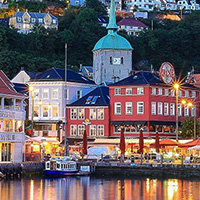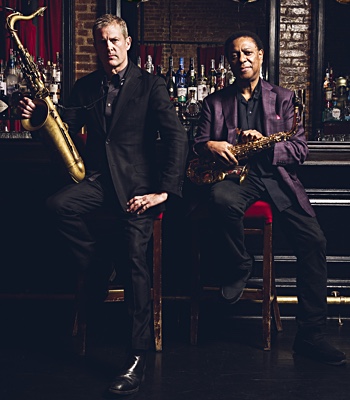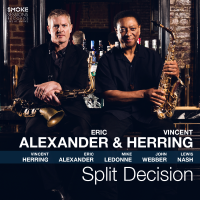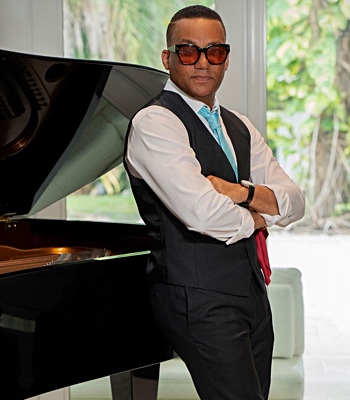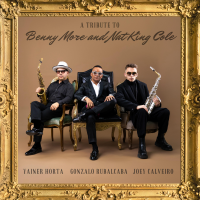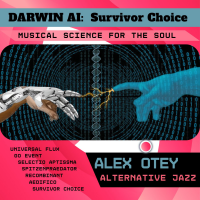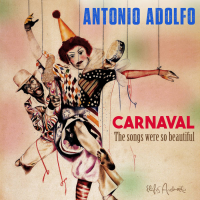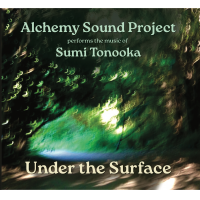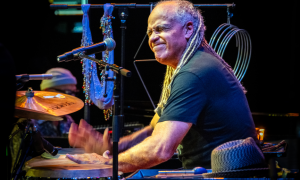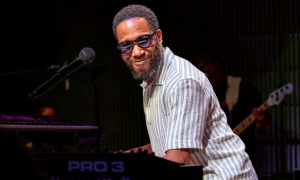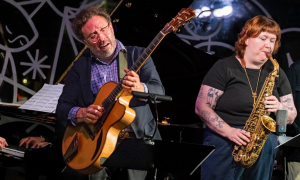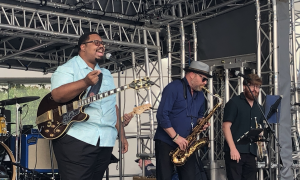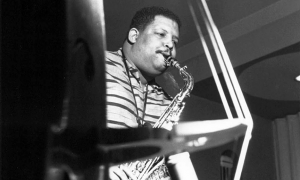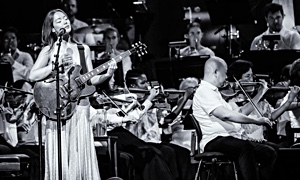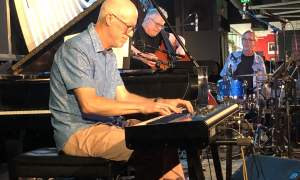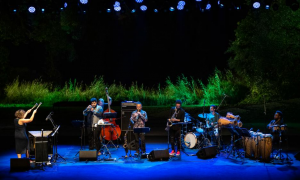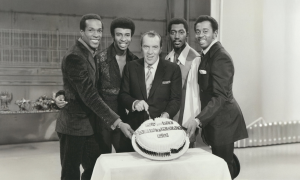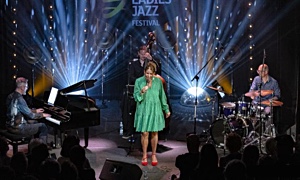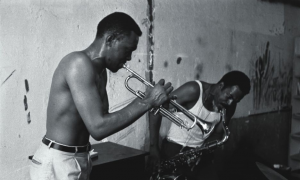Home » Jazz Articles » Live Review » Norwegian Jazz 101a: JazzNorway in a Nutshell 2009
Norwegian Jazz 101a: JazzNorway in a Nutshell 2009
One of the challenges of any organization or festival is to find ways to top past performances, and certainly the breadth of exposure to Norwegian music, culture and geography at JazzNorway in a Nutshell 2008 (JNiaN) would be hard to beat. A junket where approximately 40 people from around the world—writers, photographers, festival programmers, club owners and others—congregated in Norway for a few days of intensive exposure to all things Norwegian, the 2008 edition was an astounding success, with its combination of private performances for the group and access to the many shows at Stavanger's Mai Jazz 2008 festival.
Coupled with fjord trips and stays in small but stunning locations like Rosendal, it created the lasting impression of a country where no idea is too outrageous, and no border ever fixed and immovable.
If the recent American television documentary series Icons Among Us: Jazz in the Present Tense taught anything, it was that jazz may have begun as an American art form but is no longer its proprietorship. An inclusive music where artists look for inspiration from sources far and wide to cross-pollinate into an ever-expanding continuum, jazz is now truly a world music.
Based on the various performers recruited specifically for JNiaN attendees and those performing at Bergen's Nattjazz festival—the focal point for JNiaN 2009—it's difficult to deny that Icons Among Us posited ideas that Europeans have known for years. If the beginning of jazz can be found in African- American roots music, it now includes the traditional music of cultures far and wide, with Norway's rich folk tradition but one of many now imbuing jazz with new life, and a healthy future.
Chapter Index
- Arriving in Bergen / Nils Petter Molvær / Speeq
- Mount Fløyen / JNiaN Begins / Kjetil Møster
- Nattjazz: Arve Henriksen Trio / Terje Rypdal, Crimescene
- Voss Extremes and Sidsel Endresen/Håkon Kornstad
- Nattjazz: Bobo Stenson Trio / Ola Kvernberg Trio + 1
- Cornelius på Holmen / Nils Økland
- Nattjazz: Jon Balke, Pratagraph / Lekverk
- JazzNorway in a Nutshell 2009 Wrap-Up
Arriving in Bergen / Speeq / Nils Petter Molvær
Overnight flights can be a trial under the best of circumstances, and every trip to Norway is a reminder of the unsettled life of the traveling musician. While the best thing to do is stay up the following day until early evening so that a good night's sleep can be had (making it possible to quickly adjust to the six-hour time difference), sometimes it's simply not meant to be. While JNiaN didn't officially begin until May 21, 2009, arriving on May 20, the first day of Nattjazz, meant that there were shows impossible to miss—among them the Norwegian free improvisation group Speeq, with special guest vocalist Phil Minton, and Norwegian Nu Jazz progenitor, trumpeter Nils Petter Molvaer and his trio.
Bergen, Norway's second largest city next to Oslo and, at nearly a thousand years old, considered "the gateway to the fjords" is, like so many Norwegian towns, built in and around water on the country's west coast. An aerial view from Mount Fløyen— one of several mountains surrounding the city—reveals inlets and peninsulas that make navigating the city more than a little complicated. While the venue where Nattjazz was taking place— USF Verftet, with its multiple performance spaces—was but a five- to-ten minute walk from the hotel where JNiaN participants were lodged, the route between included a tremendously high hill: about a 45-degree angle straight up for about 75 yards, and then the same thing straight down. The trend towards obesity, so prevalent in North America, may be beginning to hit Norway, but with geography like this it's almost an uphill battle—literally.
Attending Nils Petter Molvær's sound check—featuring guitarist Eivind Aarset and drummer Audun Kleive— revealed a much different group than last seen at Punkt 2007. While the group was smaller—no turntables, no live sampling—it was no less texturally rich and sonically expansive, with Kleive behind the drum kit making the trio a far more aggressive and improvisationally loose unit than the trumpeter's equally fine quintet of many years. Performing material from Hamada (Sula, 2009), there was considerably more weight on Molvær to create a broader palette of sound, and with a series of foot pedals allowing him to introduce various harmonies on top of his distinctive tone, even when Aarset was playing bass—reducing the group to a more straightforward trio—the music was surprisingly dense. And, as ever, the grooves were visceral and unshakable, even as Molvær's music moves further away from the techno rhythms that have been one part of his music until recently.
Attending the sound check also shed light on just how difficult the setup process is. With Molvær's rack of effects and myriad of foot pedals, and Aarset's setup looking like some portable mad scientist's laboratory, ensuring proper sound and, in the case of Molvær's performances where visuals are an equal part of the live experience, lighting (provided by Tord "Prince of Darkness" Knudsen), it's more than just hitting the stage and getting good sound in the room. It's a complex mix to ensure that not only does everything work, but that it works in concert with all around it. By the time the sound check was over, it was clear that everything was ready and that, even though the room itself was perhaps less than perfect acoustically, the sound was going to be impeccable.
Speeq, on the other hand, was as laissez-faire as could be, but in the best possible way. A trio featuring guitarist Hasse Poulsen— familiar to ECM fans for his work with French reedman Louis Sclavis on Napoli's Walls (2003)—bassist Luc Ex and drummer Mark Sanders, the group's performance was all about spontaneous invention of the most extreme kind, with Poulsen strumming so furiously on his acoustic guitar that he was breaking strings, and Ex completely avoiding any convention on his instrument as he also strummed with great abandon to create a dense, low-end rumble. In the arena of extreme, jagged improvisation, Speeq's performance was impressive, but was even more so with Minton's participation. Calling Minton a singer, however, is an understatement, as he was more a sonic partner in the freely improvised proceedings, evoking unpredictable, surprising and, at times, downright humorous sounds. But it was his clear empathy with Speeq that was most impressive; it's all too easy for music like this to sound random and disconnected, but Minton acted as a focal point for the group, pushing and pulling everyone else in ways that were undeniably connected, even as they sounded random and flagrantly spontaneous.
Mount Fløyen / JNiaN Begins / Kjetil Møster
As more of the JNiaN participants continued to arrive throughout the day on May 21, about half the group already present attended a lunch atop Mount Fløyen, sponsored by the Norwegian Ministry of Foreign Affairs, Bergen International Festival and Nattjazz. While it is, in fact, possible, to walk up the mountain, most chose to travel by funicular, a large, glass- windowed car that travels up the mountain by rail. It was possible to watch the surroundings while climbing the mountain, and see the city of Bergen begin to recede into the distance.
As rugged as the coastline of western Norway is, the chance to see Bergen from a height revealed just how lush and green it is as well. And while mountains in North America are often deserted, there were buildings scattered throughout the trip up the mountain—a dovetail with the pockets of small Norwegian towns scattered along the coast, reachable in some cases by boat alone, and in other cases by roads that cut through a swath of mountains via countless tunnels carved deep through the mountains and hills that make up the geography of the area.
While JNiaN participants were here for Nattjazz, the Bergen International Festival was taking place concurrently, focusing on classical music, theater and other artistic pursuits. The buffet lunch that took place at the Fløyen Folkerestaurant— including a wealth of fresh seafood readily available from the waters surrounding Bergen—gave JNiaN participants the opportunity to meet each other, as well as network with members of the local arts community, the Norwegian Ministry of Foreign Affairs (who helped sponsor JNiaN) and a number of artists. As ever, the expansive scope of arts support in Norway was an underlying theme as various projects were described that simply could not happen without generous arts funding. Jan Bang, co- artistic director of the annual Punkt Festival in Kristiansand, was also on hand, discussing his forthcoming album on David Sylvian's Samadhisound label, scheduled for release in 2010.
Following lunch there was time to catch some rest before the official launch of JazzNorway in a Nutshell 2009, which took place at a room in the Nattjazz venue. JNiaN's hosts—Lars Mossefin, Bo Grønninsæter and Ann Iren Ødeby—were on hand, as a group that was evenly split between participants from the 2008 edition and those new to the junket came together for the first time. One of the best aspects of JNiaN, in addition to the music and exposure to Norwegian culture, is the opportunity to bond with like-minded people from around the world. Over the course of three days, professional and personal relationships would be forged that will, no doubt, continue well past JNiaN.
While many of the performers at Nattjazz were familiar to JNiaN attendees, one of its best features is the introduction of lesser-known players through brief private concerts. At the opening buffet dinner, following brief discussions about the challenges facing promoters and journalists by North Sea Jazz Festival's Sander Grande and German National Radio personality/Jazzthing writer Karsten Muetzelfeldt, saxophonist Kjetil Møster delivered a solo performance that demonstrated the intrepid nature of the Norwegian improvising scene. Blending electronics—looping and distortion being the dominant ones—Møster's 20-minute set possessed a clear lineage back to Jan Garbarek's 1970s work, specifically his duet record with guitarist Ralph Towner, Dis (ECM, 1977).
Long pedal tones created a deep foundation for Møster's often angular lyricism. Like Garbarek, Møster was a perfect blend of ice and fire, evoking images of barren landscapes and icy Nordic cool. Even when Møster turned off the processing, his extended techniques created an unusual combination of broad intervallic leaps that punctuated his oblique melodies. Unorthodox embouchure is one of the signatures of many Norwegian horn players, and Møster was no exception, with odd multiphonics expanding and contracting his sound, as the music descended into a maelstrom of looping, screaming and overdriven horn lines, and pulses created by the dissonance of notes in close proximity. It was certainly an intense way to kick off JNiaN2009, where extreme may well have been the underlying theme.
Nattjazz: Arve Henriksen Trio / Terje Rypdal, Crimescene
There are pluses and minuses to Nattjazz's organization. On the plus side, a single pass gets its audience into the building, with the ability to wander from room to room to sample the various artists performing on any given night—usually two artists per room, for a total of six shows in the venue's three performance spaces. The problem is, however, that with people coming and going virtually throughout every performance—and alcohol being served as well—the noise factor was high, which became something of a problem, even in the louder shows. In performances like trumpeter Arve Henriksen's, it occasionally became downright intrusive.
Still, Henriksen and his trio—guitarist Eivind Aarset and sampler Jan Bang—managed to engage the audience to such a degree that, at times, there was total silence in the room, as the trumpeter captivated with new material, as well as some tracks culled from his recent Cartography (ECM, 2008).
With Bang sampling his band mates' playing in real time, processing it and feeding it back, it turned even known material into something altogether new. The subtle beauty of the performance was propelled gently by Bang's beats—even during a performance of great abstraction and impressionism—while Aarset brought new meaning to the concept of subtly nuanced support. Intuitively switching from long, drawn out chordal swells to lines taking on a middle eastern vibe with his use of an E-bow (essentially a tape head that, held just above a string, creates a sustaining vibration and unique tone), Aarset also matched Henriksen's penchant for taking his instrument to new places, the two combining sounds resembling oud and shakuhachi, respectively.
Henriksen's painfully beautiful falsetto voice contrasted, at times, with singing in his normal range, speaking through his horn while playing it concurrently. And for those who think such performances, filled with haunting beauty, are all seriousness, there were occasional moments of humor injected, with Henriksen's spoken voice saying "Oops" at one point, and drawing laughter from both his trio and the audience.
Henriksen's music links more to Norwegian traditional music and classical music than it does the American jazz tradition, but the emphasis is still on improvisation and interaction. But rather than overt displays of virtuosity, it was all about finding the moment, where three musicians join together to speak with a single voice. Whether it was Aarset brushing his strings so lightly as to barely be heard, Henriksen feeding his trumpet through processors to create a harmonized sound or Bang creating staggered beats that, in a strange way, reference African rhythms, this was music for which there seems to be little precedence. Henriksen has been honing his sound and compositional and improvisational processes for well over 15 years now, and he's never come closer to realizing his goal of creating evocative music that integrates various references in its own personal way, as he did during his Nattjazz performance.
Terje Rypdal, on the other hand, was clearly aiming for something more broad-scoped and ambitious with Crimescene, a commission for the festival that teamed the legendary Norwegian guitarist with his Skywards trio (keyboardist Ståle Storløkken and drummer Paolo Vinnaccia), the outstanding Bergen Big Band, and Danish trumpeter Palle Mikkelborg, a longtime Rypdal partner dating back to albums including Waves (ECM, 1978) and Descendre (ECM, 1980). While the use of a big band might suggest something swinging in the American tradition, Rypdal used the 17-piece ensemble more orchestrally, creating a nexus between his more rock-edged improvisational work and classical-centric albums like Q.E.D. (ECM, 1993) and Lux Aeterna (ECM, 2002).
Rypdal was in fine form, playing with a grit and edge that's been missing in recent times. Whether he was playing with a slide or his fingers, his ice-edged tone was instantly recognizable. As was Mikkelborg's, who played trumpet (muted with a Harmon mute at times) and flugelhorn, and making clear his own reference point in Miles Davis, for whom he composed the large ensemble work Aura (Columbia, 1989). Storløkken, a longtime member of Supersilent and whose new group, Elephant9, scored big with its debut, Dodovoodoo (Rune Grammofon, 2008), stuck primarily with Hammond organ, and while he only had two opportunities to solo, they were amongst the highlights of the 75-minute set. Vinnaccia, an Italian expat who has been in Norway for many years now, is a powerhouse of a drummer; he may look like an aging metal head with his black "Almost Musician" T-shirt and long, graying hair, but he's equally capable of understated color, a necessity throughout Rypdal's new composition.
The instrumentation may not have been conventional in a classical sense, but Rypdal's detailed score used horns and woodwinds in ways not unlike composer György Ligeti, with dense clusters creating sounds sometimes more felt than heard, evocative of abstract images and unusual colors. Parts of the suite were almost amorphous, yet Rypdal was clearly shaping the sounds like a potter shapes a piece of clay, gradually morphing into something more concrete and clear, where pulsing rock rhythms bolstering powerful, hard-edged solos from both the guitarist and Mikkelborg. Members of the Bergen Big Band received solo space as well, while bassist Magne Thromodsæter—also a member of the more modal blowing quintet Bungalow, who'd perform the following evening—proved to be one of the ensemble's strongest players, despite playing a largely supporting role.
Rypdal's last release, Vossabrygg (ECM, 2006), was another commission that utilized Storløkken, Vinnaccia and Mikkelborg, but it was a smaller ensemble affair that paid direct homage to electric-era Miles Davis. As fine a piece as it was, Crimescene surpassed it in scope and performance. Rypdal's playing may have stopped growing in the leaps and bounds it did in the 1970s, but combined with his constantly evolving and more sonically sophisticated writing for large ensembles, he's sounding better than he has in many years. Hopefully the time lag between this recording and its release on ECM won't be as long as the three-year gap between the performance and release of Vossabrygg.
Voss Extremes and Sidsel Endresen/Håkon Kornstad
While some JNiaN participants got up early to do some whitewater rafting, the less intrepid ones took a bus that wound through and around mountains to the town of Voss, where the rafters began their trip. Its population may be just shy of 14,000, but Voss—a beautiful town surrounded by mountains, lakes and fast-flowing rivers—calls itself "The Extreme Sports Capital of Norway," and has an international reputation amongst those for whom pursuits such as skydiving, alpine skiing, base jumping, ice diving and snowboarding have great appeal.
But it's not necessary to be an intrepid sports enthusiast to appreciate the sheer beauty of Voss and its surrounding area. The nearly two-hour drive from Bergen was filled with scenery hard to match anywhere in the world, from waterfalls to dramatic cliffs.
As those traveling to Voss by bus waited patiently in weather that was overcast and, on occasion, raining (the norm for this part of Norway), those on the rafts gradually made their way to a bridge, from which non-participants could live vicariously through their new-found friends. With drops as high as 1.5 meters in fast-moving water, the rafters had to undergo some extensive training before hitting the rapids, to ensure that if someone went overboard (someone did), it would be possible to bring him/her back aboard the raft. With such an early morning wake-up for the rafters after a late night at Nattjazz, it was a grueling but energizing experience.
As the rafters returned to their starting point, everyone was treated to a snack while watching a presentation meant to sell the idea of extreme sporting. It may not have made believers of everyone, but it did demonstrate the intrepid Norwegian combination of seemingly incompatible pursuits. The 2007 Vossa Jazz festival featured multidisciplinary performances, including one by keyboardist/composer Jon Balke that took place on the shore of a lake, and included skydivers and scuba divers working in concert with the music. By combining the emotional impact of music with the thrill of extreme sporting, Vossa Jazz broke intriguing new ground.
JNiaN attendees were also treated to a brief performance by a group of high school aged musicians, who'd been playing jazz for about 18 months. Part of a newly funded project in Voss, it proves, as ever, that cultural education works. As the Smiletones quartet worked its way through standards by Wayne Shorter, Joe Henderson and Bill Evans, the level of maturity was impressive, especially with trumpeter Børge Styve, who eschewed the virtuosic displays of technique so often heard from young players, for a sparer melodicism and compositional focus. Norwegian children are exposed, thanks to numerous arts programs funded by federal and municipal governments, to sophisticated music at an early age, and the investment continues to bear fruit as young players emerge with a surprisingly well-developed approach.
With everyone back together, a bus took the group to a hotel in Voss to sample a local champagne unique in its blend of various grapes, and a fine lunch where JNiaN participants had the opportunity to continue building on the social and professional relationships engendered by the trip. While things were running very late, there was still time for a short performance by two of Norway's most forward-thinking musicians: saxophonist Håkon Kornstad and singer Sidsel Endresen.
The two have intersected many times in the past, most recently on the Jazzland Community tour organized by Jazzland label head and keyboardist Bugge Wesseltoft, heard in a 2007 performance in Montreal, Canada and documented on the Jazzland Community (Jazzland, 2007) album. That the two could work so well together as a duo— combining Kornstad's remarkable use of electronics to create a cinematic cushion of sound with Endresen's rich voice and unprecedented acoustic techniques—was no surprise, but where the two went with the music certainly was.
While both demonstrated their individual strengths— Endresen's ability to articulate in seemingly impossible ways, taking fragments of words and twisting and turning them in new and unexpected ways; Kornstad combining a remarkable ability to create consonant multiphonics with other acoustic techniques, and blending them with looping to create expansive soundscapes— together their personal definers came together to create something new and distinct unto itself.
From song-based melodicism to jagged abstraction, this is a duo that will hopefully continue to work together in this format. Both are working on new discs (Kornstad's new release is, in fact, completed and will be out in the fall of 2009, Endresen's is likely to follow in 2010) and while it's a challenge to predict where they'll be, one thing is certain: by the time the albums are released, both musicians will have already surpassed any innovations documented on them, as has already been the case with Endresen's remarkable One (Sofa, 2007) and Kornstad's equally compelling Single Engine (Jazzland, 2007).
Before leaving for Bergen, JNiaN participants were treated to a short skydiving demonstration, as half a dozen skydivers came down from the sky, landing with precision in front of the audience. It was the perfect end to a day spent exploring yet another aspect of the intrepid Norwegian spirit.
Nattjazz: Bobo Stenson Trio / Ola Kvernberg Trio + 1
While Nattjazz's emphasis was on Norwegian artists, it did bring in some groups from farther afield, although pianist Bobo Stenson and his trio—bassist Anders Jormin and relative newcomer, drummer Jon Fält—are hardly strangers, coming from nearby Sweden. Stenson is often billed (as he was here) as "Scandinavia's Keith Jarrett," but such comparisons are in many ways unfair and long past their "best by" date. Stenson emerged around the same time as Jarrett (earlier, in fact, on ECM, as a part of the first wave of Scandinavian artists receiving international exposure through the label, also including Jan Garbarek, Terje Rypdal, Arild Andersen and Jon Christensen), and while he's as imaginative an improviser, there's less ego, less overt virtuosity in the pianist's approach to interpreting everything from Silvio Rodriguez (a personal favorite of Jormin's) and Ornette Coleman to Henry Purcell and some original material. Whereas Jarrett commands visual attention on any stage, Stenson is almost invisible...though the same could hardly be said for his music. And while it was only one aspect of the group, those who feel that European artists can't or won't swing need look no further than this trio.
Stenson's touch was as elegant as ever, although Fält has clearly lit a fire underneath the trio since replacing Jon Christensen a few years ago, a quality made abundantly clear on his debut with the trio, Cantando (ECM, 2008). He possesses the same interpretive, temporal elasticity as Christensen, as well as the legendary drummer's ability to suggest more with less, but is equally capable of being a more direct player when the need arises—as it did on the group's potent version of Coleman's "Race Face." With his surprisingly small kit he was a kinetic alternative to Stenson's quiet, reserved persona, breaking up even the most propulsive rhythms with quirky punctuations and staggered breaks.
As for Jormin, German journalist Karsten Muetzelfeldt said it best: "He's the voice of the group." Jormin's singing tone and innate lyricism were on display throughout the trio's set, although his robust tone also anchored the band when Stenson and Fä were in free flight. What distances Stenson from Jarrett is his greater attention to space and a sense, while he may be the trio's titular leader, that there's a greater collective mindset at play. The music ranged from the refined and reflective to surprisingly outgoing and even a tad expressionistic, but through it all, even when there were clearly delineated solos, there was an underlying democracy that made every piece a true three-way conversation amongst equals.
Violinist Ola Kvernberg, on the other hand, was the clear center of attention at his late night performance. With his regular trio— bassist Steinar Raknes and drummer Erik Nylander— augmented by Børge Fjordheim, who brought a number of unusual textures that included a bowed saw to his array of percussion instruments, Kvernberg drew largely from his latest album, the irrepressible Folk (Jazzland, 2009).
Starting with the buoyantly slap-dash rhythm of "Roland," Kvernberg quickly got the audience's attention with his octave violin, an instrument tuned an octave below a normal violin. Strumming it like a guitar before grabbing his bow to deliver its languid theme, Kvernberg also used a series of foot pedals to subtle effect, creating a rhythm loop to drive the more folksy lyricism of "Mariam."
The additional percussionist could have cluttered things up, but Fjordheim worked in perfect concert with Nylander, creating layers of rhythm that drove Kvernberg's concise solos to greater heights, bolstered by Raknes' penchant for grabbing onto a pattern and milking it for all it was worth. Kvernberg took the majority of the solos throughout the set, and that was largely a good thing as Raknes, for instance, was a far better accompanist than he was a soloist.
The music ranged from hip hop-inflected to folkloric, with a fiery exchange between Kvernberg and Nylander at the start of the hard-swinging, modal "John" the closest Kvernberg came to the intense free play of his work in bassist Ingebrigt Håker Flaken's quintet. Kvernberg's music was eminently accessible while being undeniably substantial, and if Folk is one of the best releases of 2009, the violinist's performance at Nattjazz stands as one of the festival's high points.
Cornelius på Holmen / Nils Økland
For JNiaN's final day, the group was taken off the coast of Bergen by boat to Holmen, an island where the Cornelius restaurant offers imaginative seafood cuisine taken from the waters surrounding the small island. Scallops, sea urchins and oysters were but a few of the delicacies offered raw to JNiaN participants, along with some fine wine to complement it.
The island is a brief 20-minutes from the heart of Bergen by boat, with the restaurant's seating capacity approximately 250. With gorgeous views of the surrounding islands and fjords, it's hard to imagine a more beautiful place to enjoy a meal, and the grounds surrounding the restaurant have been cultivated to make any visit to the restaurant an experience that transcends merely going somewhere pleasant for a meal.
With 4,500 annual guests since 2007, a trip to Cornelius is more than just a terrific sit-down meal. Groups coming to the island are met by one of the restaurant's owners, Alf Roald Sætre—also known as "Shellfish Man"—who offered drinks and raw seafood to JNiaN members, along with an engaging story of how the restaurant came to be, delivered with the perfect timing of the best comedian.
Tanks in the walkways surrounding the restaurant's five large rooms kept fish, lobster and other shellfish on display, as everyone gradually made their way into the largest room for a sumptuous lunch of fish soup, salad, crab, prawn and fresh bread. Following the meal and speeches from local arts representatives, violinist Nils Økland gave a brief performance on hardanger fiddle and viola d'amore. Both instruments resemble traditional violins, but have additional strings that, situated below the strings that are played, resonate sympathetically. The instruments also have more strings than the conventional four-string violin (usually seven or more), and are tuned in various ways, just as guitars often are for traditional folk music.
Økland is a true master of these instruments, referencing the rich Norwegian folk tradition while largely focusing on original material, some from his new ECM album, Monograph (2009). As with his performance at Punkt 08, the violinist's touch was impeccable, drawing delicate nuances out of his instruments with the lightest touch of the bow, making this all-acoustic performance all the more vivid. Økland introduced each piece with some information about the instrument being used and the source of the song. With nothing but his feet to create a pulse during the more propulsive tunes, Økland represented a sharp contrast to the effects-laden musicians who may be mining similar territory for inspiration, but are approaching it from an entirely different angle.
Returning to the hotel for a brief pause before a final evening at Nattjazz, JNiaN participants reflected on just how well the entire trip had been coordinated, a perfect combination of networking and social interaction, fine music and exposure to Norway's stunning geography and distinct culture. Each night, after the Nattjazz performances, the Key Club provided a low-key place for JNiaN members to relax, talk about their individual work and reflect on the music they'd heard throughout the day, as well as pick up promotional material from the various artists participating at JNiaN and Nattjazz.
Nattjazz: Jon Balke, Pratagraph / Lekverk
While Nattjazz would continue on for another week, its final night for JNiaN participants was one of absurd humor. Keyboardist Jon Balke and his percussion-driven Batagraph (ECM, 2006) project teamed with two of Norway's most popular radio personalities— Espen Beranek Holm and Are Kalve—for Pratagraf, a performance that combined quirky instrumental music with humorous spoken word. While understanding the Norwegian dialog would have made it all the more entertaining, much like Shellfish Man at Cornelius, the delivery was so perfect—and so absurd—that it was funny, even to those who had no idea what was being said. And, as ever, Balke's music created a perfect foundation; a soundtrack that was both improvisational and structured to work in concert with Holm and Kalve's equally knotty and idiosyncratic spoken words.
With drummer Jon Fält clearly someone to watch with the Bobo Stenson Trio, and given his penchant for injecting a certain element of humor into the trio's music, it was no surprise to discover that his own group, the collective Lekverk, took that rife sense of humor even further. While the trio—also featuring pianist Adam Forkelid and bassist/primary spokesperson Putte Frick- Meijer Johander—mixed a curious combination of near-slapstick humor and unmistakable musicianship on its debut, 21st Century Jump (Parallell, 2008), live the group took its comic sensibilities much further.
While some of its antics might be considered over the top, the fact is that the trio communicated on a deep level; so deep, in fact, that it was able to stop on a dime and go to unexpected, spontaneous flights of crazy dialog and instrumental silliness— with Fält a commanding presence as he took an already warped and broken cymbal, attempting to tear a strip off it and, ultimately, using that strip as an alternate texture.
The trio veered into free territory, but with the kind of absurd slapdashery that was equal parts multi-instrumentalist Han Bennink and Buster Keaton. Forkelid might start a tune with a repeated low-end note on his piano only to be stopped by Fält, who would take a cymbal, place it on his head and pretend to be deep in prayer...but only for a moment, before the entire group would break down in laughter and then suddenly coalesce into a structured tune like the staggered pulse of "Var Inte Rä Nu," where a broad, intervallic piano line acted as the basis for a solo from Johander that demonstrated abilities far beyond those of simply a crazed comedian.
While Lekverk's music seemed to be almost pieced together as an afterthought, it became clear, as the 90-minute set progressed, that there was far more consideration at play. Groove mixed with individual and collective free play to create a curious musical mix where structure veered onto a collision course with freedom steeped in multiple, self-evident traditions, even when brought together in such unusual combinations as to seem, on the surface, incongruous. Johander, Forkelid and Fält worked to create both unified and disparate sounds that made Lekverk's performance another high point of the festival.
JazzNorway in a Nutshell 2009 Wrap-Up
As JNiaN participants met for the last time at the end of the evening of May 23 at the Key Club to reflect on the three days of exposure to the richness of Norwegian culture and say their goodbyes, it became clear that the trip had been more than just a junket. With new friendships forged, a deeper understanding of the multifaceted music that Norway has to offer, in addition to its culture and politics, JazzNorway in a Nutshell 2009 was, like its 2008 predecessor, a resounding success.
The following morning, as participants began dispersing to locations near and far, there was an overriding sense of camaraderie formed that was remarkable for a group that had only come together three days prior. While there were, of course, people who knew each other from past years and other festivals, there were also plenty of new bonds formed, and if JazzNorway in a Nutshell is about exposure to Norwegian culture in order to get it out into the world, equally it's about relationships that help keep not only Norwegian music alive and growing, but music from all cultures, as the diverse mix of people from around the world talked about the distinctive music scenes from their own countries.
A remarkable three days of music, scenery and conversation, JazzNorway in a Nutshell is rapidly becoming the benchmark for exposing a country's culture to the world. With each year bringing something new to the table, it's impossible to imagine what the 2010 edition will bring, but one thing is certain: it will be well worth the trip to find out.
Tags
Comments
PREVIOUS / NEXT
Support All About Jazz
 All About Jazz has been a pillar of jazz since 1995, championing it as an art form and, more importantly, supporting the musicians who make it. Our enduring commitment has made "AAJ" one of the most culturally important websites of its kind, read by hundreds of thousands of fans, musicians and industry figures every month.
All About Jazz has been a pillar of jazz since 1995, championing it as an art form and, more importantly, supporting the musicians who make it. Our enduring commitment has made "AAJ" one of the most culturally important websites of its kind, read by hundreds of thousands of fans, musicians and industry figures every month.




